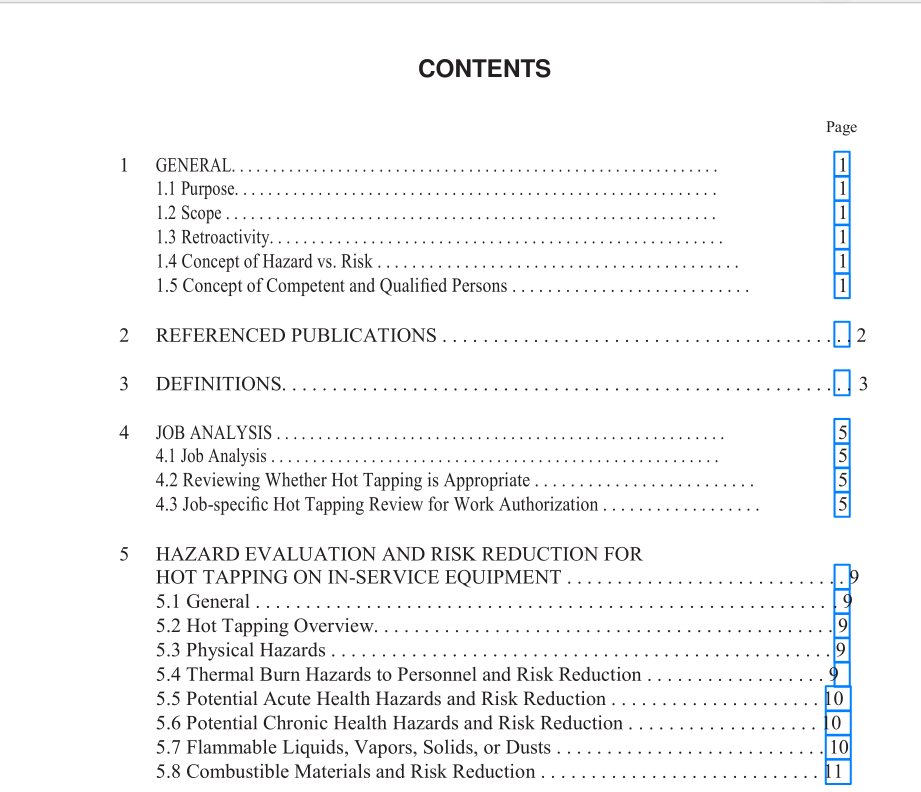API RP 2201 pdf download

API RP 2201 pdf download.Safe Hot Tapping Practices in the Petroleum & Petrochemical Industries
1.2 SCOPE
Hot tapping is the technique of attaching a welded branch fitting to piping or equipment in service, and then creating an opening in that piping or equipment by drilling or cutting a portion of the piping or equipment within the attached fitting. (In certain specific situations a bolted or mechanical fitting may be used. This approach is not common practice in oil processing and petrochemical facilities and this document does not address any considerations unique to “hot tapping without welding”.) Hot tapping is usually performed when it is not feasible, or is impractical, to take the equipment or pip- ing out of service, or to purge or clean it by conventional methods. With proper review to determine that a hot tap is appropriate, and development and conformance to job-spe- cific procedures, many hot tap connections have been safely made without interfering with the process operation. This publication covers the safety aspects to be considered before and during hot tapping on in-service piping or equip- ment. It provides: · aids to recognize, review, and address safety concerns; · a review of potential hot tapping concerns based on industry experience; · guidance on planning hot taps; · application of “hazard versus risk” concepts applied to hot tapping; · elements to consider during the hot tap process from job analysis through completion; · suggestions on “what to do if things go wrong.” This publication is not: · a substitute for job-specific planning; · a set of work procedures. Virtually every hot tapping job is different. A detailed, written, job-specific hot tap procedure should be available before starting each job to help ensure that appropriate mea- sures are addressed. If there are standing procedures for hot tapping they should be reviewed for applicability to the spe- cific job to be done. These procedures may need revision in 1 response to unique job specific problems or situations that may arise concerning the safety of personnel and facilities.
1.3 RETROACTIVITY
Any provisions in this publication related to design are intended for reference when designing new facilities or when considering major revisions or expansions, or establishing new programs. It is not intended that any recommendations in this publication be applied retroactively to work performed at existing facilities. This recommended practice should provide useful guidance when there is a desire or need to review pro- cedures, programs or facilities.
1.4 CONCEPT OF HAZARD VS. RISK
Hazards are properties of materials with the inherent abil- ity to cause harm. Flammability, toxicity, corrosivity, stored chemical or mechanical energy all are hazards associated with various industrial materials. Risk requires exposure. A hot surface or material can cause thermal skin burns or a cor- rosive acid can cause chemical skin burns, but these can occur only if there is contact exposure to skin. There is no risk when there is no potential for exposure. Determining the level of risk involves estimating the prob- ability and severity of exposure that could lead to harm. While the preceding examples relate hazards to the risk to people, the same principles are valid for evaluating property risk. For instance, hydrocarbon vapors in a flammable mix- ture with air can ignite if exposed to a source of ignition resulting in a fire which could damage property.
1.5 CONCEPT OF COMPETENT AND QUALIFIED PERSONS
OSHA uses the term “competent person” in dozens of standards for persons serving a variety of roles. In other stan- dards the term “qualified person” is used. Sometimes both terms are used in the same standard. This recommended prac- tice also uses these terms. The following sections explain this usage. In both cases it is the employer who has the responsi- bility for designating the person.









